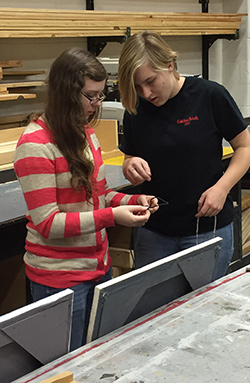Commissions
Why Badges? (Part 2)
 For those sold on the idea of using badges to track student learning, the next logical step is implementation.
For those sold on the idea of using badges to track student learning, the next logical step is implementation.
The most basic approach is to begin the system in the classroom. Demonstrating the success of a badge system in a single course will provide data that may open doors to a program wide rollout. In the School of Theatre at George Mason University in Fairfax, Virginia, badges have been introduced and the use is still expanding. Feedback from shop heads, faculty, administration, and the students has been very positive.
Course implementation
Not every course is badge appropriate. Technical theater courses that include demonstrating specific skills built into the learning objectives are the most successful. Beginning with an introduction to technical theatre course, required for all theater majors, badges were awarded to students who mastered specific skills like reading a ground plan and spiking a set, writing a professional email, changing over props, hanging and focusing an ERS, hand-sewing, drafting a room in scale, knot tying, building a soft cover flat, accomplishing a wardrobe quick change, and assembling a simple sound system. Most badges were part of in-class active learning but could be easily earned during lab hours. Some badges were earned as part of assignments that were graded, but most of the badges had no bearing on class assessment. For the pilot program, only sticker badges were used. However, a digital badge system will be implemented in future iterations.
Shop implementation
Once a student has demonstrated mastery of a skill, they require less supervision in a shop and can actually become shop interns or teach incoming students, essentially creating an apprenticeship program. Beginner scene shop badges may include a simple safety check on the various power tools – table saw, band saw, chop saw, panel saw, drill press (as examples). As students become more advanced, additional badges may be added: flat building, woodcarving, welding, specific painting techniques, or any skill valuable to the shop. The same kinds of skills can be identified in the costume shop for badge implementation.
Over time students, faculty, and shop supervisors can track students’ progress throughout their educational career. The digital badge system is a much better long-term solution with open access to anyone involved. Experience shows the students truly want the sticker badges. While every institution will implement digital badges differently it may be very helpful to look to USITT’s eSet certification standards as a starting point.
To read more about badges in educational settings, see Part I in the July issue of Sightlines.

